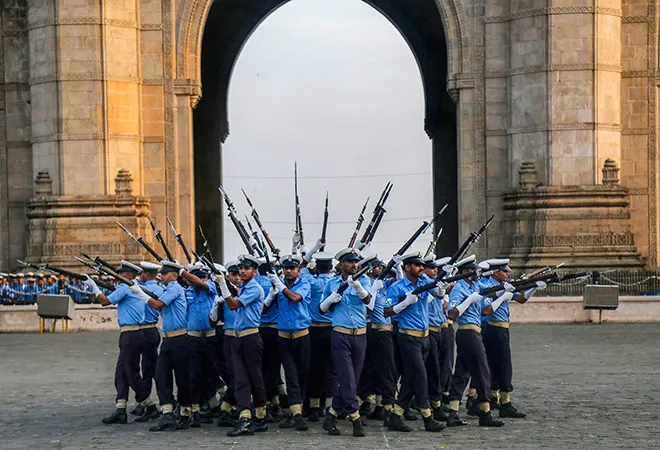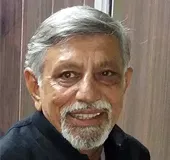-
CENTRES
Progammes & Centres
Location
India’s service chiefs would need to lay down their priorities. These would involve a mix of operational and non-operational tasks.

Image Source: PTI — Representational image
Navy Day, December 2018
2018 was an eventful year for the armed forces. The army spent the year in bringing down levels of militancy in Kashmir. It launched its own cadre review, seeking to cut down manpower and restructure its organisations. It also released its latest Land Warfare Doctrine on 19 December.
The three services continue to be service specific and differ on the following.
Apart from inducting deep submergence rescue vehicles, the navy also had the Arihant complete its first deterrence patrol leading to the completion of the triad, though one such submarine alone does not imply a comprehensive triad. The air force is preparing for the induction of the Rafale aircraft, Chinook and Apache helicopters. The Air Force also conducted its first air-to-air refuelling of the Tejas aircraft after commencing its induction into the force. The S400 missile deal signed between India and the US would bolster the country’s air defence.
Simultaneously, the armed forces were impact by multiple decisions taken by the Ministry of Defence, viewed by many to be “anti-military.” The opening of cantonments, considering permitting those covered under Ayushman Bharat to be treated in over stretched military hospitals, continued litigation against the orders of the Armed Forces Tribunal in the apex court, bureaucratic attempts to take over the Canteen Stores Department are few such instances.
2018 also witnessed the creation of Defence Planning Committee under the National Security Advisor (NSA). The committee includes senior bureaucrats from the ministries of defence, external affairs and finance, apart from the three service chiefs. It is created to enhance defence procurements, but not much appear to have moved in the last year. This creation puts to rest all hopes of reorganising apex management of defence by creating a Chief of Defence Staff (CDS) because the NSA would perform that role.
In December, the navy chief and Chairman Chiefs of Staff Committee, Admiral Sunil Lanba, had stated in an interview that the three service chiefs had accepted the proposal to create a Permanent Chairman for the Chiefs of Staff Committee (PCCOSC). This appointment has until now been held by the senior-most serving chief, hence it was not permanent, but almost rotatory. Admiral Lanba also claimed that this proposal was forwarded to the government. In his opinion, this could be the closest to the CDS and he would be the single point military advisor to the government.
A lot has happened in 2018, some beneficial, some damaging. While proposals have been placed before the government, approvals are awaited. New structures have been created — benefits of which are yet to be seen.
Thus, as 2019 commences, the service chiefs would need to lay down their priorities for the year. These would involve a mix of operational and non-operational priorities. Some aspects would be service specific, while others would be joint aspects.
Among all the aspects, priority should be on pushing the government to announce the PCCOSC. The PCCOSC’s appointment, midway to a CDS, would still provide joint commands a responsible head and be at a stage better than present. The army’s recently issued Land Warfare Doctrine would then be a part of a joint doctrine that would synergise the operational concepts of the three services and enhance counter-threat capabilities.
The next joint aspect should be to synergise efforts to ensure that military institutions are not targeting, in the process being lost to the central services. If this is ignored, the impact on the serving staff and those of the veterans would be high, creating angst among them.
The final joint aspect will be to push through pending anomalies of the last pay commission, including the recent rejection of enhanced military service pay for JCOs by the Ministry of Finance. The morale of the services will be enhanced if the government is convinced of approving Non-Functional Upgradation, specific to the armed forces.
Through the Departmental Promotion Committee the services would seek an enhanced budget this year, as the last budget was considered the lowest (in percentage terms) since the 1962 India-China war. However, considering the year 2019 is an election year, such a hope is unrealistic — there may be another year of difficult financial management.
With the army undergoing major structural reforms, 2019 would prove to be a major test. Exercises to implement changes in organisations would have concluded and amendments to its proposed structures would be near finalisation by end of 2019. It is important that this is implemented at the earliest, as the army continues to prepare for future threats with structures of the past.
Considering the year 2019 is an election year, such a hope is unrealistic — there may be another year of difficult financial management.
Other aspects of reform, seeking to enhance satisfaction levels of the service cadre, restructure its organisation in New Delhi would require government approval, which will possibly see the light of day once the new government assumes office. However, continuous engagement would be the only means of faster approval.
With elections scheduled for later this year, there would be attempts by Pakistan to create problems in the Kashmir valley. Tensions along the border would remain, as would attempts at increased infiltration. This implies adopting a firmer stance and a no-nonsense approach in the valley, while ensuring minimum collateral damage. The army would thus need to re-strategise and possibly even deploy additional forces.
The navy and the air force are preparing for new inductions in 2019. The navy would be inducting INS Karanj, a Scorpène-class submarine and three Landing Craft Utility vehicles this year. It must pursue the development of its second aircraft carrier, ensuring it is not delayed beyond 2020.
The air force would be inducting its Apache and Chinooks helicopters alongside its first Rafale jets and enhanced Tejas fighters. Both the services would be moving forward improving capabilities and being better prepared in countering threats. Amalgamating new inductions into existing doctrines and plans is a major aspect, which the air force must concentrate.
A lot has happened in 2018, some beneficial, some damaging. While proposals have been placed before the government, approvals are awaited. New structures have been created — benefits of which are yet to be seen. Service chiefs need to identify their priorities, join hands and work together to ensure that damages are reduced, capabilities enhanced and morale of the services restored.
The views expressed above belong to the author(s). ORF research and analyses now available on Telegram! Click here to access our curated content — blogs, longforms and interviews.

An alumnus of the National Defence Academy Major General Harsha Kakar is a graduate of the DSSC LDMC and the National Securities Studies Course at ...
Read More +